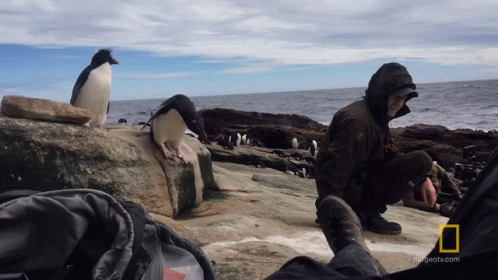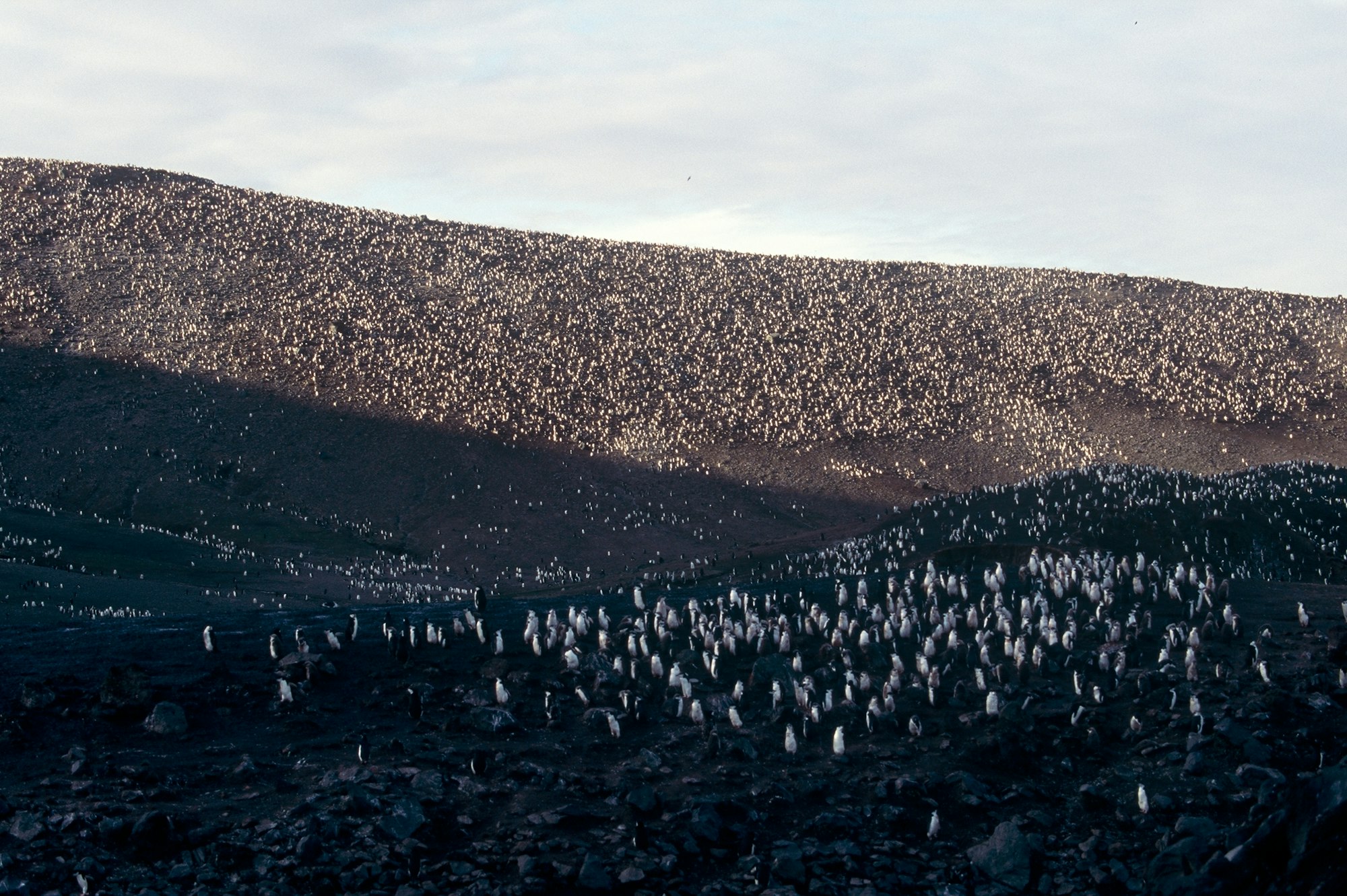52 Weeks of Writing: Week 31—What Matters In Storytelling As Demonstrated By Penguins
Let's talk about penguins. Specifically, let's talk about how penguins can help us learn about how to write good, compelling story structure.

Let's talk about penguins. Specifically, let's talk about how penguins can help us learn about how to write good, compelling story structure.
Penguins are great, aren't they. They're also potentially one of the more ludicrous of all species out there, like slightly tipsy party-goers at 1am, coming out of one of those black-tie gatherings and somehow mired on islands at the very bottom of the world. Penguins have few natural predators on land, so they tend to be curious about humans rather than scared of them. Hence all of those times they've shown up to investigate when humans are studying them.
Penguins also feature heavily in an episode of Planet Earth II. I started watching the series because I wanted some nature inspiration for writing Amnar, and this felt like a good fit. The soothing voice of David Attenborough explaining the redness of nature in tooth and claw. As I watched each episode, I began noticing how each one is broken up into a series of discreet stories. Every one follows a similar pattern. The patterns are simple, but they reveal a lot about how to develop a story that's so compelling, it's impossible to look away.
So, those penguins.

The penguins live on a lonely volcanic island at the bottom of the world. This is Zavodovski, and it is entirely populated by chinstrap penguins. A million of them, thereabouts. At the beginning of the segment, David Attenborough introduces the island's location, and we see shots of this place that, while not lost under Antarctic snow, is as remote a place as you could possibly get. There's no life to speak of besides these penguins and a host of sea birds who prey on their vulnerable chicks.

The documentary provides us with a setup, location, and follows a few of the penguins around. During chick season, the penguin couples take turns walking two miles from their nesting site out to sea to get food and then bring it two miles back again to feed their baby. This is ignoring, for the moment, the horrors they face at the island's inhospitable coast and in the violent seas that surround it.
We have a setup, therefore, and a problem: the penguins must find food for their chicks, and it doesn't exist on the island itself. Therefore, there must be a quest. The camera introduces us to an unnamed penguin, and because this is a penguin, we're instantly engaged. After all, what could be sweeter than watching a chinstrap penguin waddle two miles across a lava plain to a rocky and raging coastline for the sake of its baby?
We follow the quest and it's only at the coast when the stakes ramp up. This is where we hit the meat of the story, heading for the midpoint break. In order to get into the sea where the food is, the penguins must fling themselves off high black rocks into the surging waves. It's one of the hardest things I've watched all year, and I've been following some pretty intense YouTube drama lately. Delicate little penguin bodies fall through the air in a cascade, bouncing off the ocean below.
Even the penguins who make into the water have no easy ride. We're in the midst of the quest now. Hunting for food puts them at risk of attack from those huge seabirds. A brief reminder of the peril at home, as birds pluck at those small fuzzy penguin-blobs on the island, waiting for their other parent's return.
Once the penguins are full of food, they then have to get back onto the island. The rocky coast is effectively a jagged wet wall of rock, and if you've ever seen penguins before, you'll know intensive free-solo climbing is not in their skillset. Broken and bruised, many will not make it. This is not only a vital point in the story—a reminder of risks and stakes—but a very real trauma for the penguins. They must somehow ride the waves to the shore, fly up onto the rocks and risk broken bones to get onto the land.
The camera shows us the aftermath as if we were watching the end of a Lord of the Rings epic. Penguins, their white feathers matted with dark blood, waddle along the muddy and narrow paths back up onto the lava plain. They look exhausted, but hold out their wings in that way penguins do so often, as if they are carrying shopping bags back from Tesco. The shopping bag is, in fact, in their stomachs, now much more rounded than before they made their first leap.
We are now deep into the final moments of the story. We've faced the cataclysms of the coast, the water, the risks of getting in and out, and now we face one final, dramatic hurdle. The penguin must find their mate and their chick in amongst a horde of a million penguins. It's noisy, it's windy, it's cold. The penguin is tired and blood-soaked. It waddles amongst the many, many other penguins, trying to find its specific black-and-white mate in a sea of other, almost identical black-and-white strangers.
Back in the nest, parent and chick are starting to get desperate. There are birds overhead. We don't even need to see pictures of what happens to the chicks whose parents don't make it, or are too late with the food. We know, by this point, and we're willing our penguin hero to get home safe.
True to all BBC nature documentaries, the drama is both real but also understated. The returning parent is always an odd combination of endearing and comical in the way it raises its head and wings, the way it finally stumbles over to the nest site, the way it bobs its head in a dance of greeting to its mate.
It's a relief, and the story resolves. Of course, because this is nature and the chick still needs to be fed, the story is not a complete resolution. This only one arc in an ongoing tale. The other parent is already on their way out to sea when the cameras depart.
Lisa Cron reminds us throughout her books that stories are the essence of how humans communicate. Will Storr says very much the same thing. Watching a BBC nature documentary might seem like a break from narratives, but it's actually where they shine the most. This is probably what makes the Life, Planet Earth, and other series so successful. They understand that in order to persuade us to pay attention, they have to tell us a good story.
It's not just about the violence of nature. It's about this one small, imperfect being struggling against the elements. Note that the penguin has limitations, that it is that delightful combination of funny and tragic. Of course, not all the stories in these documentaries are about penguins (although March of the Penguins was—remember what a coup that was for the movie world?). The balance of character exists throughout the stories, whether we are following predator or prey.
In writing these documentaries, the authors are always clear about the protagonist, the people we're rooting for. Where we have to make a horrible choice—between starving lion and young giraffe, for example—the story is nuanced enough to suggest that we can empathise with both. When the lioness fails to catch the giraffe, we can be relieved for the giraffe while the writer hints that things might look better for the lioness in the future. We can hang on to bear witness to that.
The protagonists are nuanced in their development. A penguin is funny but determined. A lioness is powerful but hungry, limited by long spells without food and by an inhospitable desert environment. The story provides an arc with enough danger to present the viewer with risk, but also the possibility of overcoming it. Note that although lessons are often sold as a powerful element in story-building, this isn't so much of an issue here. We are the ones who get to walk away with whatever lesson we feel is important.
We always know the stakes, we know the risks, and the story is clear about both. It's also clear about the hazards each protagonist must face in order to get what they want and need. It made me wonder if a lot of the time we—or I, at least—overthink story, trying to pile in so many technical points, absorbing and using every minute piece of advice, until our stories are weighed down with a lot of nonsense they don't need. I've just read two books that made me feel that way and I've enjoyed writing Amnar more, once I stopped worrying about that.
So thank you, penguins, thank you.

